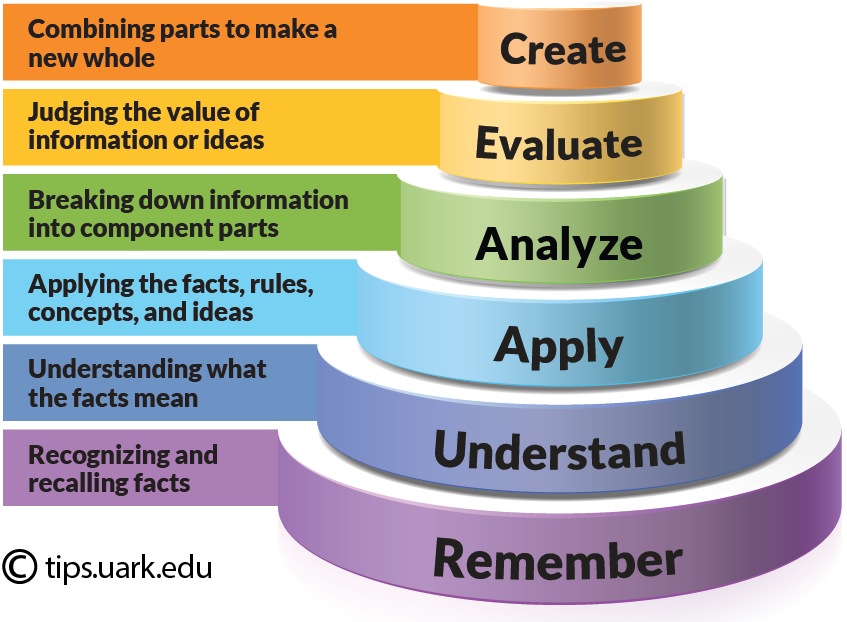The following is a guest blog post from Meilianty Gunawan. Meili completed an Instructional Design internship with OSU Ecampus during Fall 2021.
Have you ever driven a car on a highway with no streetlights in the middle of the night? Your first instinct is to turn your car’s high-beam lights on to give you greater visibility on what lies far ahead of you. You are probably fine just by relying on the car’s low-beam lights, but you will not be able to get a clearer picture of the far end of the road as you would get from the high-beam.
Bloom’s Taxonomy is a framework used by instructors to develop course learning outcomes. It lays out six cognitive domains (from basic to more advanced) and examples of measurable action verbs along with those domains.

When course learning outcomes are set from the point of students’ knowledge and skills deficiency, students are inadvertently deprived of the greater things that they were able to achieve after completing the course. Lower-division courses (100- and 200-level courses) generally focus on the lower-order cognitive processes in Bloom’s Taxonomy. However, there are expectations for the upper-level and graduate-level courses to focus more on the higher-level of cognitive processes. This expectation was clearly spelled out in the Upper-and Lower-Division course policy that was approved by the OSU Faculty Senate Curriculum Council in April2021.
Therefore, instead of looking at the knowledge or skills students are lacking, try thinking along the following lines to stretch the course learning outcomes into the higher-level thinking processes:
- What can the students do after they have met the lower-level portion of the learning outcomes?
- What if all my students scored “A” in their prerequisite course(s) or they are so academically prepared to take the course?
- What if all my students had mastered the lower-level skills required and they liked problems that are more challenging?
- How can my students apply the skills and knowledge from the course to their professional work?
When courses aim for the higher-order cognitive domains in their learning outcomes, it inadvertently drives the assessment away from the traditional factual memorization type of assessment that is generally entailed mainly in the ‘remembering’ and ‘understanding’ cognitive realms.
As an illustration, we will use the following learning outcome as a baseline:
“Describe the winemaking process”

Describe is a verb under the ‘understanding’ cognitive process. While it is good that students are able to describe the wine-making process, think again about the greater purpose of them being able to describe the wine-making process. Why do they need to be able to describe the winemaking process? Is it so that they can recommend the best process, compare and contrast various processes, evaluate the suitability of a process, etc?
The following are some of the suggested revisions to the above learning outcome that are geared towards the higher-order thinking in Bloom’s and how it impacts the ways students are being assessed.
- Recommend a suitable winemaking process to produce a product with industry-accepted specifications.
- Recommend falls under the ‘evaluating’ cognitive domain. In the assessment, the instructor can give a list of specifications of the final product (e.g., the color, purity, turbidity of the wine) and ask the students to recommend a suitable winemaking process. In the quest of selecting and recommending the suitable process, the students are exercising critical thinking skills and potentially problem-solving skills, especially if they need to suggest certain optimization in the process to produce the product with the right specifications.
- Evaluate the feasibility of a certain wine-making process under specified conditions.
- For the assignment, the instructor can present a case study of company X that wants to do a start-up business in making wines. Given the specified capitals, resources, and expected lead time for the product, the students need to evaluate if the winemaking process in question is feasible. By justifying their yes or no answer, they are practicing the synthesis, reasoning, and argumentative skills which fall under the higher-order thinking process.
- Compare and contrast the different winemaking process commonly used in the industry.
- Compare and contrast are within the ‘analyzing’ and ‘evaluating’ cognitive domains. To measure this learning outcome, the instructor can ask the students to compare and contrast the processes A, B, and C. The instructor can also award points if the group is able to illustrate their explanations with the aid of diagrams. By comparing, contrasting, and illustrating the different winemaking processes, the students are having a more in-depth analysis of each process and how they are being similar or different from one another.
So, the next time you are thinking about the course learning outcomes, you may want to picture them in the context of their entirety and see them in the grand scheme of things; just like how you would have seen the far distance after turning that car’s high-beam on!
